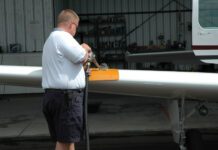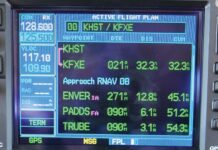When I am doing check rides, training and instrument proficiency checks, I take a lot of notes. My goal is to write down symptoms needing attention, such as altitude deviation or airspeed mismanagement, and find solutions. Most pilots strive for professionalism, and they work with me to identify those solutions.
During post-flight briefings, I start by asking students to complete a self-evaluation. If there are any deviations from standards, typically students can point them out. I would like to think I earn my keep by helping them figure out why. The following are the most common notes I have taken, with solutions to situations where pilots have either deviated from standards or ended up in an unsafe situation on an instrument approach.
WASTING TIME
During initial instrument training, it feels like there is never enough time to do anything. The lessons jump from approach to approach, trying to cram as much practice with approaches, going missed, holding, you name it. In other words, it is busy. My instructor always said to me, “If you are doing nothing, you are missing something.” When pilots transition to true mission flying, they often find there is a lot more dead air. Cruise flight can be fairly dull, and that is typically a good thing. Due to the way training is typically conducted, pilots are used to setting up and briefing approaches in the terminal environment. Even in slower airplanes, it is worth being ahead. Use that valuable, boring cruise time to get the aircraft (and yourself) into the best position to transition from the en route to the terminal and approach phase.
It is wise to have a plan prior to descent. Every approach and landing has two (typical) outcomes. One is a taxi to parking; the other is missed to a hold. It still surprises me how many pilots land with zero idea where they intend on going on the airport, and what is expected. What do you think happens when an unplanned missed occurs? Use that boring cruise time. Set up and brief. There will absolutely be times where your plan is ruined and all that preparation will be negated, but it is still worth the work.
EXPECT THE UNEXPECTED
I know, it is easier said than done, right? Remember the first few times you flew into a busy uncontrolled airport? It seemed like chaos. Managing the airplane is a handful while trying to search for traffic and keep track of everything. After some practice, most pilots can usually paint a picture of the pattern after monitoring the frequency. “There is a Skyhawk taxiing to the runway, a Cirrus on the practice approach and a Seneca on the left downwind.” Doing this is a fantastic boost to situational awareness.
This same level of situational awareness is useful in the terminal IFR environment. Is ATC asking for a certain speed to the FAF? Is there faster traffic behind you? Do they want more space to accommodate departures? You can paint the same mental picture, and plan your configuration and approach to facilitate this. I love when I hear phrases like, “Okay, we are on vectors, looks like a long left downwind. I will put the first notch of flaps in three miles before the FAF and the gear and checklists will be done before glide slope intercept.” Seeing the top-down picture keeps the pilot ahead of the airplane, which is critical because once the approach begins, things happen quickly.

Continuation bias is the unconscious cognitive bias to continue with the original plan in spite of changing conditions. I am of the opinion that a large portion of aviation accidents are caused by continuation bias. Get-there-itis is a form of continuation bias, but get-there-itis is typically a conscious hazardous attitude that considers the inconvenience of not getting home above safety of flight. Most pilots are mission-driven, type A personalities. When given a goal, we are not happy until that goal is completed.
Continuation bias is a big reason why so many bad approaches end up in even worse landings. The vast majority of unstabilized approaches do not result in go-arounds. Even professional pilots, sometimes operating under programs that track every single data point that airplanes can possibly offer, will force a landing under conditions that warrant a go-around.
This is where thinking of gates comes in handy. By 1000 feet above minimums, the aircraft should be configured with checklists completed. Depending on the aircraft and your usual mission, consider creating your own gates at 500 feet and 200 feet. In my aircraft, by 500 feet to minimums, I am at my desired speed +20/-0. By 200 feet, I am on-speed.
Creating gates like this forces a choice, and avoids snap decisions involving complicated questions such as, “Will I be able to slow down and land in the touchdown zone from this speed?” Creating firm spots on every approach where there are simple standards for continuing or going missed helps prevent continuation bias.
THE FINAL APPROACH FIX
The final approach fix (FAF) is the first gate on your approach. In this context, a “gate” is a trigger to ensure that the airplane is in a desired position. For the FAF, the aircraft should be configured, checklist completed and in a position to descend from the appropriate altitude. When pilots are caught off guard by the FAF or glide slope intercept, the resulting approach is almost never pretty. The aircraft begins high, and the pilot is forced to chase the appropriate path.
My recommendation is to have a plan for the FAF. When I reach the FAF, I pitch the aircraft to the appropriate nose-down attitude and reduce power. Knowing approximate pitch and power settings for a stable approach is ideal. If the approach begins on the correct path, it is much easier to keep that way.
FIXATING, OVERCORRECTING
To fixate is human. If one has an issue, the immediate desire is to fix it. This is true when flying instrument approaches. Consider an aircraft high on the glide path. Frequently, I will see pilots pitch down, track the correction and end up right back on glide path. During this correction, the localizer will drift or the airspeed will creep up. As challenging as it is, when something is askew, make a correcting action and look away. The key to avoiding fixation is to have an optimized scan. When I transitioned from transitional steam gauges to a glass cockpit, I had to reoptimize my scan. Dealing with instrument failures and reversionary modes create the same challenges.
Fixation and overcorrection go hand in hand. A poor scan leads to more frequent corrections. If a pilot is high on profile and pitches down too far, by the time their scan reaches the glide path again, they are low. Many refer to this as “chasing the needles.” Just like one must consciously scan to avoid fixation, one must consciously make minor corrections to avoid overcorrection. The challenge is allowing things to right themselves slowly. Preventing these errors will help keep your needles centered, which is especially critical when the sensitivity increases while approaching the decision altitude (DA).

A stabilized approach is one in which the pilot establishes and maintains a constant-angle glidepath toward a predetermined point on the landing runway. There are several different definitions for a stabilized approach, but there are a few quantifiable characteristics:
- Briefed airspeed -0/+20
- Rate of descent no more than 1000 fpm
- The airplane is on-track and in the proper landing configuration
I have seen several pilots who add landing flaps after breaking out on the approach. There may be reasons for this, but I have never flown an aircraft where this was easier than just shooting the approach configured to land.
After glidepath interception, or after the FAF, the pilot flying requires no more than normal bracketing corrections (no more than 30 degrees of bank) to maintain the correct track.
Power settings should be appropriate for the aircraft configuration and not below the minimum power required for the approach.
Some of this is tailored to high-performance aircraft, but rarely have I seen an approach within ACS standards that would have been considered unstable. The graphic on the opposite page highlights how a steep glidepath can lead to an unstable approach.
STEPDOWNS AND MINIMUMS
If you are anything like me, 99 percent of the approaches you fly are ILS or LPV. When you end up at an airport with only non-precision approaches, some extra effort is needed. Pilots frequently forget the stepdowns. It is important to understand what type of approach you are flying and what your equipment is capable of. Many modern avionics are capable of generating a glide path for situational awareness, which is perfectly acceptable, but the onus is on the pilot to ensure they remain at or above all stepdowns.
Minimums on non-precision approaches can create confusion as well. For example, both airplanes I fly are unable to fly RNAV approaches to LP minimums. If there are WAAS or RAIM outages, the aircraft may be unable to fly GPS approaches altogether. I have had to retrain more than once because a pilot flew to straight-in minimums on a circling approach. And when transitioning to faster aircraft, it is important to remember the appropriate circling-approach categories, which are based on actual speeds, not recommended ones.

THE NEXT STEP: DA
Once you reach minimums, the work is not over. For a precision approach, things are a little simpler. Upon reaching DA, if you have the approach lights in sight you can continue to 100 feet above the touchdown zone elevation. At 100 feet, if you have the airport environment in sight, you can continue to land. If nothing is in sight, you go missed. It is simple, but it is not easy. Most of the time during instrument training, when reaching DA, the instructor tells the student to remove the Foggles. All of the sudden, the whole runway is in sight. In low-visibility conditions, this is not the case. Breaking out can be disorienting, and often an error chain can begin here. I have seen pilots level off or dive for the runway in low-visibility situations close to the ground. Successful pilots stay partially inside the aircraft, ensuring the aircraft stays on-speed and on-profile.
THE NEXT STEP: MDA
Non-precision approaches add another layer of complexity. Instead of reaching a DA, the pilot levels off at a minimum descent altitude (MDA). This is the first spot for a common error: leveling off at MDA without adding power. Generally, the aircraft is configured to land and low to the ground. If the pilot does not add power, airspeed rapidly bleeds off and a stall is imminent. This is especially prevalent when conducting approaches with the autopilot engaged.
The second gotcha occurs after leveling off. The missed approach point (MAP) on many non-precision approaches aligns with the threshold of the runway. Usually crossing the threshold at 500 feet agl or so is not conducive to a safe landing. Many approaches publish a visual descent point (VDP), which as its name implies identifies a point on the approach where normal descent from MDA may be commenced.
Beyond the VDP, the descent from MDA to the runway will be steeper than usual. This may work at a 10,000-foot runway or in a slower airplane. It is critical to land in the touchdown zone, especially in shorter or contaminated runways. Trust your instincts, and if it feels like you are forcing the aircraft down, make the safe call and go around.
PUTTING IT ALL TOGETHER
Like anything else in flying, there are countless things that can go wrong on approaches. Automation errors, airspeed mismanagement and loss of situational awareness, to name a few. Modern aircraft and avionics help tremendously. For example, I was amazed the first time I flew an approach with a flight director, and we have so many more automated tools today.
Many of these pitfalls can still occur on an approach flown with an autopilot, and every aircraft I have flown has different failures that can result in flying approaches the old-fashioned way. Keeping some of these more common errors and solutions in mind while flying approaches can break the accident chain before it can develop.
Ryan Motte is a Massachusetts-based Part 135 pilot, flight instructor and check airman. He moonlights as Director of Safety when he isn’t flying.




